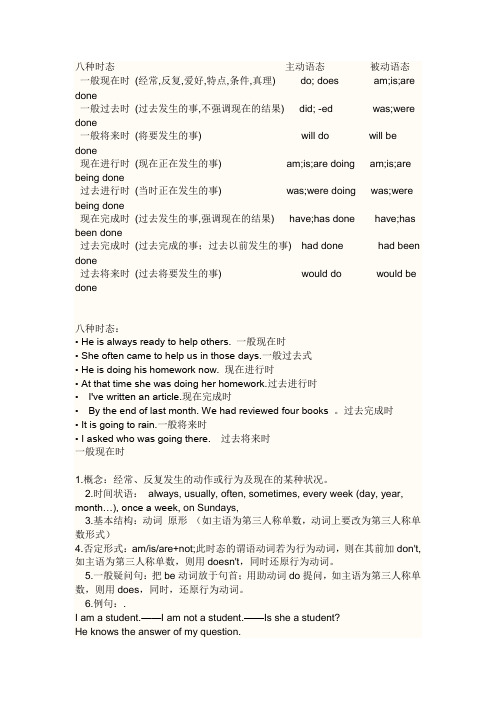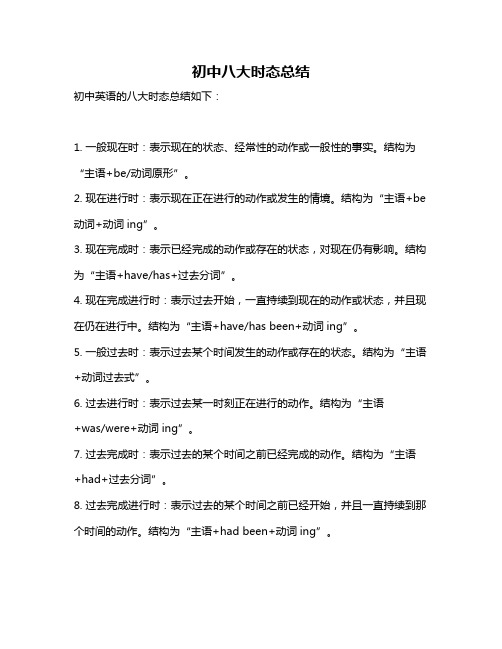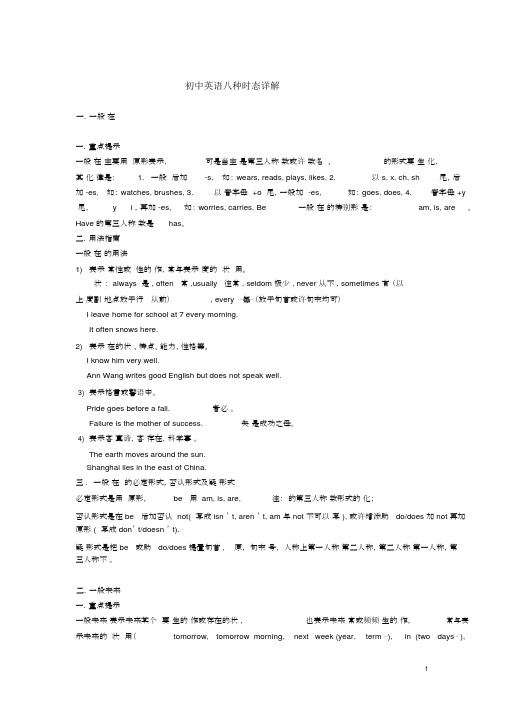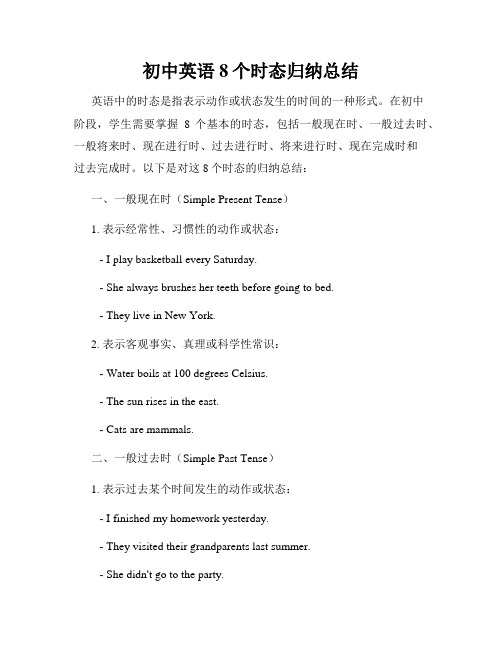(完整word版)初中英语八种时态讲解
(完整版)英语中八种常见时态常用时间状语归纳

英语中八种常见时态常用时间状语归纳一、一般现在时1. 概念:表示现阶段经常发生的动作或现在的某种状况,也表示客观事实、客观规律或客观真理。
谓语动词要用原形,主语是第三人称时,谓语动词要用第三人称单数形式。
2. 常见时间状语标志:always, often, sometimes, usually, every day, on Sundays, once a day / week / month等。
例如:I do some exercise every day. 我每天做一些锻炼。
She knows French and German besides English.除英语外,她还懂法语和德语。
The sun rises in the east. 太阳从东边升起。
二、一般将来时1. 概念:表示将来发生的动作或存在的状态,以及打算、计划或准备做某事。
2. 常见时间状语标志:tomorrow, the day after tomorrow, next day / week / month / year…, this week / month / year, soon, in + 时间状语(如in one hour / in a few minutes等),in the future, in future等。
例如:I’ll take you there tomorrow. 我明天带你去那儿。
Next month we will have our school open day. 下个月我们将迎来学校开放日。
The Talent Show is coming in two weeks’ time. 新秀选拔演出还有两周时间就要到了。
三、一般过去时1. 概念:表示在过去的某个时间发生的动作或存在的状态,也表示过去习惯性、经常性的动作。
谓语动词要用过去时。
2. 常见时间状语标志:yesterday, the day before yesterday, last night / week / month, 时间词+ ago (如three days ago), in / on + 过去的时间词(如in 2010), just now, at that time, in those days, one day, long long time ago, once upon a time等。
初中英语时态8种基本时态讲解

初中英语时态8种基本时态讲解初中英语中,常见的有8种基本时态,分别是:一般现在时、现在进行时、现在完成时、一般过去时、过去进行时、过去完成时、一般将来时和过去将来时。
以下是这8种基本时态的详细讲解:1. 一般现在时:表示经常发生的动作或存在的状态。
结构为“动词原形/动词的第三人称单数形式”。
例如:“I have a cat.”2. 现在进行时:表示正在进行的动作。
结构为“be动词+动词的现在分词”。
例如:“She is reading a book.”3. 现在完成时:表示过去的动作对现在造成的影响或完成的动作。
结构为“have/has+动词的过去分词”。
例如:“I have finished my homework.”4. 一般过去时:表示过去发生的动作或存在的状态。
动词形式为“动词的过去式”。
例如:“She was at the park yesterday.”5. 过去进行时:表示在过去某一时刻正在进行的动作。
结构为“was/were+动词的现在分词”。
例如:“They were having dinner at 6 o’clock.”6. 过去完成时:表示过去的过去,即某个过去的动作之前已经完成的动作。
结构为“had+动词的过去分词”。
例如:“By the end of last year, they had built 500 houses.”7. 一般将来时:表示将来要发生的动作或存在的状态。
结构为“will+动词原形”或“am/is/are going to+动词原形”。
例如:“We will visit the museum next week.”8. 过去将来时:表示从过去的某一时刻看,将来要发生的动作或存在的状态。
结构为“would+动词原形”或“was/were going to+动词原形”。
例如:“He said he would come back soon.”以上就是初中英语8种基本时态的讲解,希望对你有帮助!。
(完整word版)八种时态主动语态被动语态

八种时态主动语态被动语态一般现在时(经常,反复,爱好,特点,条件,真理) do; does am;is;are done一般过去时(过去发生的事,不强调现在的结果) did; -ed was;were done一般将来时(将要发生的事) will do will be done现在进行时(现在正在发生的事) am;is;are doing am;is;are being done过去进行时(当时正在发生的事) was;were doing was;were being done现在完成时(过去发生的事,强调现在的结果) have;has done have;has been done过去完成时(过去完成的事;过去以前发生的事) had done had been done过去将来时(过去将要发生的事) would do would be done八种时态:• He is always ready to help others. 一般现在时• She often came to help us in those days.一般过去式• He is doing his homework now. 现在进行时• At that time she was doing her homework.过去进行时• I've written an article.现在完成时• By the end of last month. We had reviewed four books 。
过去完成时• It is going to rain.一般将来时• I asked who was going there. 过去将来时一般现在时1.概念:经常、反复发生的动作或行为及现在的某种状况。
2.时间状语:always, usually, often, sometimes, every week (day, year, month…), once a week, on Sundays,3.基本结构:动词原形(如主语为第三人称单数,动词上要改为第三人称单数形式)4.否定形式:am/is/are+not;此时态的谓语动词若为行为动词,则在其前加don't,如主语为第三人称单数,则用doesn't,同时还原行为动词。
初中八大时态总结

初中八大时态总结
初中英语的八大时态总结如下:
1. 一般现在时:表示现在的状态、经常性的动作或一般性的事实。
结构为“主语+be/动词原形”。
2. 现在进行时:表示现在正在进行的动作或发生的情境。
结构为“主语+be 动词+动词ing”。
3. 现在完成时:表示已经完成的动作或存在的状态,对现在仍有影响。
结构为“主语+have/has+过去分词”。
4. 现在完成进行时:表示过去开始,一直持续到现在的动作或状态,并且现在仍在进行中。
结构为“主语+have/has been+动词ing”。
5. 一般过去时:表示过去某个时间发生的动作或存在的状态。
结构为“主语+动词过去式”。
6. 过去进行时:表示过去某一时刻正在进行的动作。
结构为“主语
+was/were+动词ing”。
7. 过去完成时:表示过去的某个时间之前已经完成的动作。
结构为“主语+had+过去分词”。
8. 过去完成进行时:表示过去的某个时间之前已经开始,并且一直持续到那个时间的动作。
结构为“主语+had been+动词ing”。
以上是初中英语八大时态的总结,希望对你有所帮助。
(完整)初中英语八种时态详解

初中英语八种时态详解一.一般在一.重点提示一般在主要用原形表示,可是当主是第三人称数或许数名,的形式要生化,其化律是: 1.一般后加-s,如:wears, reads, plays, likes, 2.以s, x, ch, sh尾,后加 -es,如:watches, brushes, 3.以音字母+o尾,一般加-es,如:goes, does, 4.音字母+y 尾,y i ,再加 -es,如:worries, carries. Be一般在的特别形是:am, is, are。
Have 的第三人称数是has。
二.用法指南一般在的用法1)表示常性或性的作,常与表示度的状用。
状: always 是 , often 常 ,usually 往常 , seldom 极少 , never 从不 , sometimes 有(以上度副地点放于行从前), every ⋯每⋯(放于句首或许句末均可)I leave home for school at 7 every morning.It often snows here.2)表示在的状、特点、能力、性格等。
I know him very well.Ann Wang writes good English but does not speak well.3)表示格言或警语中。
Pride goes before a fall.者必。
Failure is the mother of success.失是成功之母。
4)表示客真谛,客存在,科学事。
The earth moves around the sun.Shanghai lies in the east of China.三 .一般在的必定形式,否认形式及疑形式必定形式是用原形,be 用 am, is, are,注:的第三人称数形式的化;否认形式是在 be 后加否认 not( 写成 isn ’ t, aren ’ t, am 与 not 不可以写 ), 或许增添助 do/does 加 not 再加原形 ( 写成 don’ t/doesn ’ t).疑形式是把 be 或助 do/does 提置句首 , 原,句末号,人称上第一人称第二人称,第二人称第一人称,第三人称不。
8个初中英语时态

8个初中英语时态8个初中英语时态是学习英语语法的重要组成部分,以下是它们的定义和例句:1. 现在一般时态:表示现在的动作或状态。
例如:I eat an apple every day. (我每天吃一个苹果。
)2. 过去一般时态:表示过去的动作或状态。
例如:She studied English last year. (她去年学了英语。
)3. 现在进行时态:表示正在进行的动作或状态。
例如:He is watching TV now. (他正在看电视。
)4. 过去进行时态:表示过去某个时间正在进行的动作或状态。
例如:They were having dinner when I called. (我打电话的时候他们正在吃饭。
)5. 现在完成时态:表示已经完成的动作或状态,强调对现在的影响。
例如:I have learned English for three years. (我已经学了三年英语了。
)6. 过去完成时态:表示过去某个时间之前已经完成的动作或状态。
例如:They had finished their homework by the time I arrived. (我到的时候他们已经完成作业了。
)7. 现在完成进行时态:表示从过去开始一直持续到现在的动作或状态,强调对现在的影响。
例如:He has been studying English for five years. (他已经学了五年英语了。
)8. 过去完成进行时态:表示从过去某个时间开始一直持续到过去的动作或状态。
例如:They had been waiting for the bus for an hour when I arrived. (我到的时候他们已经等了一个小时的车了。
)。
初中英语8个时态归纳总结

初中英语8个时态归纳总结英语中的时态是指表示动作或状态发生的时间的一种形式。
在初中阶段,学生需要掌握8个基本的时态,包括一般现在时、一般过去时、一般将来时、现在进行时、过去进行时、将来进行时、现在完成时和过去完成时。
以下是对这8个时态的归纳总结:一、一般现在时(Simple Present Tense)1. 表示经常性、习惯性的动作或状态:- I play basketball every Saturday.- She always brushes her teeth before going to bed.- They live in New York.2. 表示客观事实、真理或科学性常识:- Water boils at 100 degrees Celsius.- The sun rises in the east.- Cats are mammals.二、一般过去时(Simple Past Tense)1. 表示过去某个时间发生的动作或状态:- I finished my homework yesterday.- They visited their grandparents last summer.- She didn't go to the party.2. 表示过去的经历或习惯:- When I was young, I often went swimming. - He always ate breakfast at 8 o'clock.三、一般将来时(Simple Future Tense)1. 表示将来要发生的动作或事件:- I will go shopping tomorrow.- They are going to have a picnic next week. - She won't be late for the meeting.2. 表示将来的打算或意愿:- I am going to be a doctor when I grow up.- We will help you with your project.四、现在进行时(Present Continuous Tense)1. 表示现在正在进行的动作:- We are studying English at the moment.- He is playing soccer with his friends.- They aren't watching TV right now.2. 表示现阶段的趋势或变化:- The population is increasing rapidly.- More and more people are using smartphones.五、过去进行时(Past Continuous Tense)1. 表示过去某一时间段内正在进行的动作:- I was reading a book when the phone rang.- They were cooking dinner at 7 o'clock.2. 表示过去的同时发生的两个动作:- She was listening to music while doing her homework.六、将来进行时(Future Continuous Tense)1. 表示将来某一时间段内正在进行的动作:- Tomorrow, they will be flying to Paris.- I will be waiting for you at the station.2. 表示将来的预测或计划:- This time next month, I will be studying for my exams.七、现在完成时(Present Perfect Tense)1. 表示过去某一时间发生的动作对现在造成的影响或结果: - I have finished my homework, so I can watch TV now.- She has already eaten lunch.2. 表示过去某一时间内多次发生的动作:- We have visited that museum several times.八、过去完成时(Past Perfect Tense)1. 表示过去某一时间点之前已经完成的动作:- By the time they arrived, we had already left.- I had finished my work before the deadline.2. 表示过去的顺序或先后关系:- She realized that she had forgotten her keys after she locked the door.以上是初中英语的8个时态的归纳总结。
(完整版)初中英语八大时态语态总复习时态讲解.docx

初中英语八大时态语态总复习时态讲解一般现在时态【展示平台】1 一般现在时态用来表示经常,反复,习惯性发生的动作或存在的状态,常与表示频率的副词 sometimes(有时) , often(经常), usually(通常), always (总是)等连用。
时间状语in the morning/ afternoon/ evening(在上午/下午 / 晚上) , every day/ week/ month/ year(每天/周/月/年, at noon/night (在中午 / 夜里) , on Monday/Tuesday (在星期一 / 二)等也可用在一般现在时态中。
如:Bruce usually walks to school.We have two P.E classes every week.布鲁斯通常步行去上学。
我们每周上两节体育课。
2 表示现在的特征或状态。
如:She is always ready to help others.He is 13 years old. 他 13 岁了。
她总是乐于助人。
3表示事实或客观真理,或在谚语中,也用一般现在时。
如:The sun rises in the east and sets in the west every day.太阳每天东升西落。
When there is a will, there is a way.有志者,事竟成。
4一般现在时的基本句型1)肯定句:①主语+动词原形+其他②主语(第三人称单数)+ 动词 -s+ 其他如: They live in China.他们住在中国。
He likes eating apples.他喜欢吃苹果。
2)否定句:①主语+don’t+动词原形+其他②主语(第三人称单数) +doesn’t+ 动词原形如: They don ’t live in China.他们不住在中国。
He doesn’t like eating apples.他不喜欢吃苹果。
- 1、下载文档前请自行甄别文档内容的完整性,平台不提供额外的编辑、内容补充、找答案等附加服务。
- 2、"仅部分预览"的文档,不可在线预览部分如存在完整性等问题,可反馈申请退款(可完整预览的文档不适用该条件!)。
- 3、如文档侵犯您的权益,请联系客服反馈,我们会尽快为您处理(人工客服工作时间:9:00-18:30)。
时态列表比较及具体运用一般现在时一.要点提示一般现在时主要用动词原形表示,但是当主语是第三人称单数或者单数名词时,动词的形式要发生变化,其变化规律是:1. 一般动词后加-s, 如:wears, reads, plays, likes2.以s, x, ch, sh结尾,后加-es, 如:watches, brushes3.以辅音字母+o结尾,一般加-es, 如:goes, does4.辅音字母+y结尾,变y为i,再加-es, 如:worries, carries.5.Be动词一般现在时的特殊形态是:am, is, are6.Have的第三人称单数是has。
二.用法指南一般现在时的用法1) 表示经常性或习惯性的动作,常与表示频度的时间状语连用。
时间状语:always总是, often经常,usually通常, seldom很少, never从不, sometimes有时(以上频度副词位置放于行为动词之前), every…每…(放于句首或者句末均可)I leave home for school at 7 every morning.It often snows here.2) 表示现在的状态、特征、能力、性格等。
I know him very well.Ann Wang writes good English but does not speak well.3) 表示格言或警句中。
Pride goes before a fall. 骄者必败。
Failure is the mother of success. 失败是成功之母。
4) 表示客观真理,客观存在,科学事实。
The earth moves around the sun.Shanghai lies in the east of China.三. 一般现在时态的肯定形式,否定形式及疑问形式1.肯定形式是用动词原形,be动词用am, is, are, (注:动词的第三人称单数形式的变化;)2.否定形式是在be动词后加否定词not(缩写成isn’t, aren’t, am与not不能缩写),或者添加助动词do/does加not再加动词原形(缩写成don’t/doesn’t).3.疑问形式是把be动词或助动词do/does提置句首, 动词还原,句末问号,人称上第一人称变第二人称,第二人称变第一人称,第三人称不变。
一般将来时一.要点提示一般将来时表示将来某个时间要发生的动作或存在的状态,也表示将来经常或反复发生的动作,常与表示将来的时间状语连用tomorrow, tomorrow morning, next week (year, term…), in (two days…), soon, the day after tommorrow等。
二.用法指南一般将来时的结构及用法1) shall/will + 动词原形,shall用于第一人称,常被will 所代替,will 用于各人称,表示未来的事实或对将来的预测。
Which paragraph shall I read first.?Will you be at home at seven this evening?Students will use computers to learn.2) be going to +动词原形,表示打算,计划要做的事或根据有把握的判断要发生的事。
a. 主语的意图,即将做某事。
What are you going to do tomorrow?b. 计划,安排要发生的事。
The play is going to be produced next month。
c. 有迹象要发生的事Look at the dark clouds, there is going to be a storm.3) be to +动词原形,表示已作出的决定,按计划或正式安排将发生的事。
We are to discuss the report next Saturday.4) be about to +动词原形,表示即刻,马上要发生的动作。
He is about to leave for Beijing.注意:be about to 不能与tomorrow, next week 等表示明确将来时的时间状语连用。
Be 动词的形式与主语保持一直。
四. 某些将来时结构在用法上的区别1)be going to 和will用于条件句时,be going to表将来;will表意愿If you are going to make a journey, you'd better get ready for it as soon as possible.Now if you will take off your clothes, we will fit the new clothes on you in front of the mirror.2)be to和be going tobe to 表示客观安排或受人指示而做某事;be going to 表示主观的打算或计划。
I am to play football tomorrow afternoon.(客观安排)I'm going to play football tomorrow afternoon. (主观安排)五.一般将来时的肯定形式,否定形式及疑问形式1.肯定形式正常语序2.否定形式在be动词或will/shall后加not3.疑问形式把be动词或shall/will提置句首。
现在进行时一.要点提示现在进行时的结构:be (am, is, are) + 现在分词(即动词-ing形式)。
动词现在分词的变化规律:1. 一般情况下,动词后直接加-ing,如:working, buying, visiting,2. 以不发音的e结尾的动词,去掉e,然后再加-ing, 如:taking, having, leaving,3. 以辅音字母+元音字母+辅音字母结尾的重读闭音节,双写末尾辅音字母,然后加-ing,如:stopping, running, swimming,4. 特殊变化,如:lie—lying.二.用法指南现在进行时的基本用法:1)表示现在( 指说话人说话时) 正在进行或发生的动作。
We are waiting for you.2)习惯进行:表示长期的或重复性的动作,说话时动作未必正在进行。
Mr. Green is writing another novel. (说话时并未在写,只处于写作的状态。
)She is learning piano under Mr. Smith.3)表示渐变的动词有:get, grow, become, turn, run, go, begin等。
The leaves are turning red.It's getting warmer and warmer.4)与always, constantly, forever 等词连用,表示反复发生的动作或持续存在的状态,往往带有说话人的主观色彩。
You are always changing your mind.三. 不用进行时的动词1) 事实状态的动词have, belong, possess, cost, owe, exist, include, contain, matter, weigh, measure, continue等。
I have two brothers.This house belongs to my sister.2) 心理状态的动词know, realize, think see, believe, suppose, imagine, agree, recognize, remember, want, need, forget, prefer, mean, understand, love, hate等。
I need your help.He loves her very much.3 ) 瞬间动词accept, receive, complete, finish, give, allow, decide, refuse等。
I accept your advice.4) 系动词seem, remain, lie, see, hear, smell, feel, taste, get, become, turn等。
You seem a little tired.四.现在进行时态的否定形式是在be后加not,疑问形式是把be动词提置句首。
一般过去时一.要点提示一般过去时是表示在过去的时间里发生的动作,动词用过去式(即动词-ed形式),动词过去式的变化规律:1 一般动词词尾加-ed, 如:walked, looked, finished,2 以字母e结尾的动词后加-d,如:lived, decided, noticed,3 以辅音字母加y结尾的动词,变y为i,再加-ed,如:hurried, carried,4 以元音字母加一个辅音字母结尾的重读闭音节动词,先双写该辅音字母,再加-ed, 如:stopped, stepped。
以上是规则变化,还有一些动词的过去式是不规则变化,如:do—did, have—had, be—was/were, swim—swam等,参见初一下英语书后不规则动词表。
二.用法指南一般过去时的用法1)在确定的过去时间里所发生的动作或存在的状态。
时间状语有:yesterday, last (week, nighr, year…), (an hour…) ago, in 1982, just now等。
Where did you go just now?2)表示在过去一段时间内,经常性或习惯性的动作。
When I was a child, I often played football in the street.Whenever the Browns went during their visit, they were given a warm welcome.三.一般过去时的一些特殊用法1.比较:一般过去时表示的动作或状态都已成为过去,现已不复存在。
Mrs. Darby lived in Kentucky for seven years. (含义:达比太太已不再住在肯塔基州。
)Mrs. Darby has lived in Kentucky for seven years.(含义:现在还住在肯塔基州,有可能指刚离去)2. 注意:用过去时态表示现在含义,表示委婉语气。
